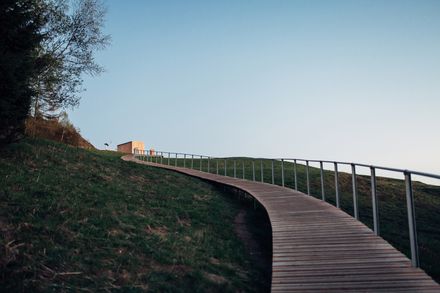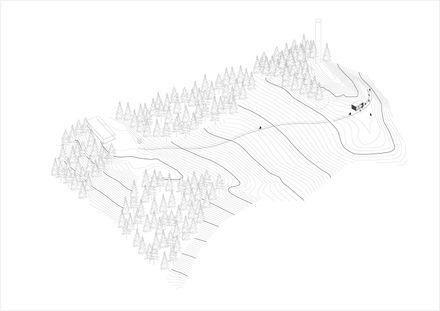
Footbridge, Shelter And Bench On Straník Hill
ARCHITECTS
2021, LABAK
LABAK
Michal Marcinov, Andrej Badin, Zuzana Demovičová
CONSTRUCTION COMPANY
SOAR
2021
Peter Lényi, Ondrej Marko, Marián Lucký
CLIENT
Tourist Board Small Fatra - an organization founded by the city of Žilina, 8 other municipalities and 16 private companies
PHOTOGRAPHS
Jana Makroczy
AREA
227.0 sqm
YEAR
2016
LOCATION
Slovakia
CATEGORY
Installations & Structures
Text description provided by architect.
Originally, the local government aimed to construct an observation tower at Straník, as the hill offers an exceptional view of Žilina – an 80 thousand industrial city in the Northwest Slovakia.
In a favorable weather, one can enjoy the view as well observe rogallos, paragliders and gliders taking off.
Local authorities therefore initiated a workshop at the site, which brought together architects (2021 and LABAK), students of architecture and all stakeholders.
The outcome of this gathering generated a consensus, that the idea of constructing a lookout tower at Straník should be reconsidered.
OBSTACKLES
Firstly, Straník itself makes a great viewpoint, because much of the hill’s crest is not forested.
Moreover, eventually it came to light that the crest of the hill was a protected national heritage site - around 10th - 12th century B.C. a hill-fort had existed here.
Although no complex archeological excavations and research have taken place here just yet, it is only a matter of time.
So in the end the ambitions to develop Straník narrowed down to: how to make this place attractive for tourists, while taking into consideration claims made by heritage conservationists, paragliders as well as forestry, because the area is also used for logging timber.
SOLUTION
Instead of introducing new elements, 2021 and LABAK mapped the existing infrastructure - the pathway, provisional shelter and the bench and translated it into contemporary architectonic language.
The subtle footbridge aims to controllably manage movement of tourists, away from the flying, and at the same time provide an easy access to the top of the hill for visitors with limited mobility.
The footbridge levitates above the terrain and the only physical contact is through ground screws.
“Since we are located in an area of potential archeological excavations and an eventual need to present them to the public, the construction is reversible.
So in case a need emerges, we can adjust the footbridge or move it,” says Peter Lényi, who is one of the authors of this project.
In the last stretch to the crest of the hill, the footbridge is discontinued in order to allow passage for the timber-logging logistics.
Then it further continues to a shelter roof, from where visitors can observe the picturesque images of rogallos, paragliders and gliding planes taking off and flying above the landscape, while munching on a sausage from a near-by food stall.
The pathway leads visitors to its end with a bench, where they can sit and enjoy the panoramic view of Small Fatra mountain range and national park, as well Žilina’s car factory.
This project used local black locust wood, which is maintenance-free, resilient to vermins as well as to changing weather conditions.




















